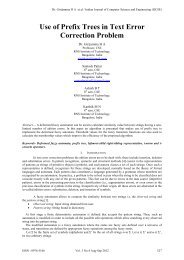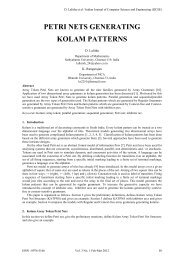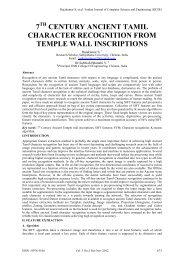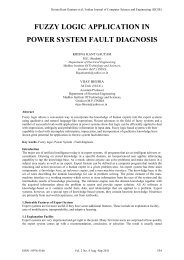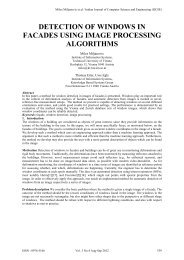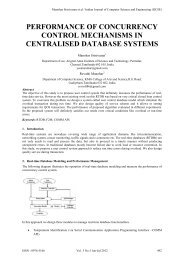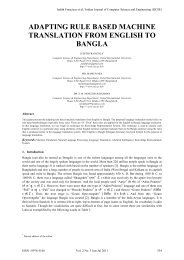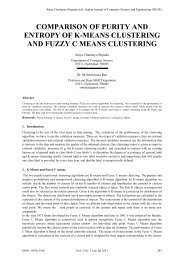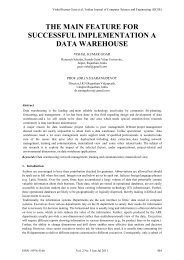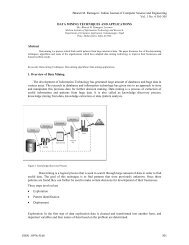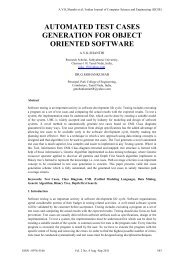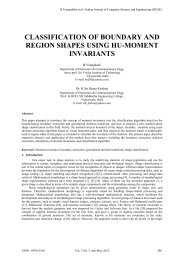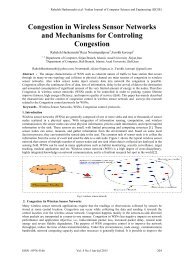a vector space model for information retrieval: a matlab approach
a vector space model for information retrieval: a matlab approach
a vector space model for information retrieval: a matlab approach
Create successful ePaper yourself
Turn your PDF publications into a flip-book with our unique Google optimized e-Paper software.
A. B. Manwar et al / Indian Journal of Computer Science and Engineering (IJCSE)<br />
and Buckley [2] showed that the <strong>vector</strong> <strong>model</strong> is expected to outper<strong>for</strong>m the probabilistic <strong>model</strong> with general<br />
collections [3].<br />
This paper implements and discusses the issues of in<strong>for</strong>mation <strong>retrieval</strong> system with <strong>vector</strong> <strong>space</strong> <strong>model</strong> using<br />
MATLAB on Cranfield data collection of aerodynamics domain.<br />
The next section deals with brief review of related work of <strong>vector</strong> <strong>space</strong> <strong>model</strong> in in<strong>for</strong>mation <strong>retrieval</strong>.<br />
2. Related work<br />
Maron and Kuhns [4] in early 1960, described probabilistic indexing technique in a mechanized library system<br />
yielding probable relevance. Afterword in 1983, Salton and McGill wrote a book [1] which discusses thoroughly<br />
the three classic <strong>model</strong>s in in<strong>for</strong>mation <strong>retrieval</strong> namely, the boolean, the <strong>vector</strong>, and the probabilistic <strong>model</strong>s.<br />
The book by van Rijsbergen [5] covers the discussion on three classic <strong>model</strong>s and majority of the associated<br />
technology of <strong>retrieval</strong> system. Frakes and Baeza-Yates [6] edited the book on in<strong>for</strong>mation <strong>retrieval</strong> which<br />
mainly deals with the data structures used in general in<strong>for</strong>mation <strong>retrieval</strong> systems. Also, it includes the issue of<br />
relevance feedback as well as some query modification techniques [7] and Boolean operations and their<br />
implementations [8]. Verhoeff, Goffman, and Belzer [9] described the shortfall of boolean queries <strong>for</strong><br />
in<strong>for</strong>mation <strong>retrieval</strong>. The concept of using boolean <strong>for</strong>malism in other frameworks had been the great interest<br />
area of the researchers. Lee et al proposed a thesaurus-based boolean <strong>retrieval</strong> system <strong>for</strong> ranking [10].<br />
Vector <strong>space</strong> <strong>model</strong> has been the most popular <strong>model</strong> in in<strong>for</strong>mation <strong>retrieval</strong> among the research vicinity<br />
because of the research outcome in indexing, term value specification in automatic indexing carried out by<br />
Salton and his associates [11, 12]. Most of this research deals with experiments in automatic document<br />
processing and different term weighting <strong>approach</strong>es <strong>for</strong> automatic <strong>retrieval</strong> [2, 13]. In 1972, Karen Sparck Jones<br />
introduced the concept of inverse document frequency, a measure of specificity [14, 15] and Salton and Yang<br />
uses it <strong>for</strong> automatic indexing to improve <strong>retrieval</strong> [12]. Raghavan and Wong [16] analyses <strong>vector</strong> <strong>space</strong> <strong>model</strong><br />
critically with the conclusion that the <strong>vector</strong> <strong>space</strong> <strong>model</strong> is useful and which provides a <strong>for</strong>mal framework <strong>for</strong><br />
the in<strong>for</strong>mation <strong>retrieval</strong> systems.<br />
The next section gives a description of the most influential <strong>vector</strong> <strong>space</strong> <strong>model</strong> in modern in<strong>for</strong>mation <strong>retrieval</strong><br />
research.<br />
3. Vector Space Model<br />
The drawback of binary weight assignments in boolean <strong>model</strong> is remediated in the <strong>vector</strong> <strong>space</strong> <strong>model</strong> which<br />
projects a framework in which partial matching is possible [11, 13]. Non-binary weights <strong>for</strong> index terms in<br />
queries and documents are used in the calculation of degree of similarity. Decreasing order of this degree of<br />
similarity <strong>for</strong> the retrieved documents gives the ranked documents with partial match.<br />
For the <strong>vector</strong> <strong>model</strong>, the weight , associated with a pair , is positive and non-binary. Further, the<br />
index terms in the query are also weighted. Let , be the weight associated with the pair ,, where<br />
, 0. Then, the query <strong>vector</strong> is defined as , , , ,…, , where t is the total number of index<br />
terms in the system. The <strong>vector</strong> <strong>for</strong> a document d j is represented by , , , ,…, , .<br />
The <strong>vector</strong> <strong>model</strong> proposes to evaluate the degree of similarity of the document d j with regard to the query q as<br />
the correlation between the <strong>vector</strong>s and . This correlation can be measured by the cosine of the angle<br />
between these two <strong>vector</strong>s as,<br />
, <br />
<br />
⋅<br />
<br />
||<br />
<br />
<br />
∑<br />
<br />
, ,<br />
<br />
∑ <br />
<br />
, ∑<br />
<br />
<br />
,<br />
where and || are the norms of the document and query <strong>vector</strong>s. The factor || does not affect the ranking<br />
(i.e., the ordering of the documents) because it is the same <strong>for</strong> all documents. The factor provides<br />
normalization in the <strong>space</strong> of the documents.<br />
Since , 0 and , 0, , varies from 0 to +1, the <strong>vector</strong> <strong>model</strong> ranks the documents according to<br />
their degree of similarity to the query. A document might be retrieved even if it matches the query only<br />
partially. [3, page 27-28].<br />
ISSN : 0976-5166 Vol. 3 No. 2 Apr-May 2012 223



